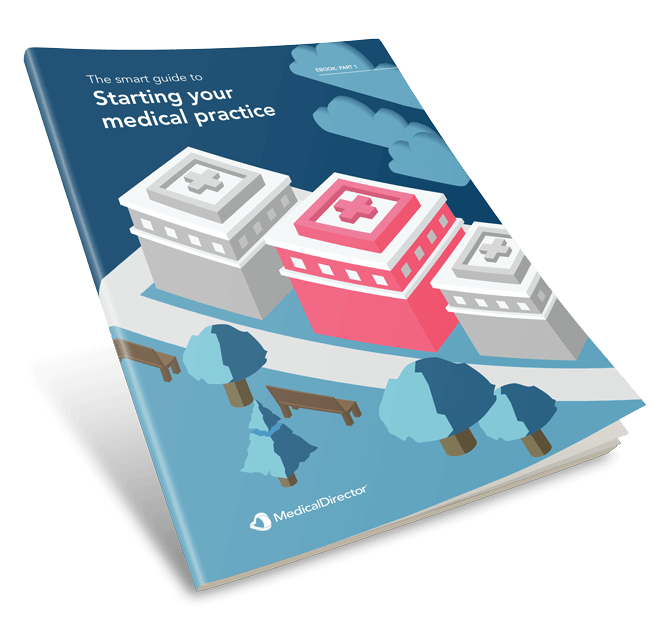The smart guide to starting a medical practice
1. Are you ready to run your own practice?
What is really motivating you?
Starting out on your own and launching a new practice can be a major personal and financial investment, and needs serious consideration and forward planning. So ask yourself first, what is really motivating you?
While it’s important to be optimistic and passionate about your vision for healthcare, you also need to be realistic about the work and dedication involved. This means taking the time to evaluate what the real reasons are for starting your own practice.
You need to weigh up the pros and cons, understand your vision and the risks. Consider the potential benefits of higher income, asset building and a more empowered professional lifestyle, and weigh them against factors such as business risk mitigation, staff management and the daily challenges of running a business.
Start with the end in mind
In order to discover what is really motivating you, you need to start with the end in mind, says Steven Macarounas, Founder of The Private Practice, which runs regular workshops for practitioners who want to set up their own medical practice. “From the beginning, you need to set your goals and stepping stones, and start with the end in mind,” Macarounas says.
“Structure your business to suit your lifestyle, not the other way around. Otherwise you run the risk of your work taking over your life. So the secret here is to set up smart, so you set yourself up for success.” “Even when you do it and do it well, there will be difficulties and challenges. But if you get it right, the rewards will be enormous – for you, your family and the wider community.” Macarounas added.
Support is critical from the start Your practice may start small, but you need to have enough foresight in your business plan to factor in growth and scale your business over time. According to Macarounas, this means seeking the right people and systems you can trust from the beginning to help support you as you embark on your new and exciting journey. “Support is absolutely critical when you’re starting out – from having the right doctors, business partners and practice managers, to the right referral systems,” Macarounas says.
Importantly, as part of this support structure, you’ll need to structure your business and invest in the right clinical management systems that offer scalable solutions and are agile enough to adapt to a growing medical practice. Conversely, you’ll also need to have an exit strategy in place in the event of your practice shutting down, or decisions to sell, have a career change – or retire.
“It’s all about having the foresight to see what makes your practice valuable from now and into the future, at the same time, you need to consider the right support systems that make you work smarter, not harder as your practice grows and becomes busier.”
Understanding the ‘business’ of running a practice
You’re a highly qualified health practitioner, but are you qualified to own and operate a business? It’s time to start thinking like an entrepreneur and a CEO. This means there are some core skills you need to learn and conquer, in order to manage the fundamental business aspects of running your own practice.
First, take the time to evaluate your own business skills. You need to be able to answer some fundamental questions about how comfortable you are about ‘running a business’ and the financial responsibility and risks associated with it.
Welcome to the new regulatory landscape
Running a practice means you not only have the responsibility to ensure your patients receive the best possible health outcomes, but that your practice structure is agile and can adapt to legal, regulatory and technological change.
If you’re serious about starting your own practice, you also need to be familiar with legislation, tax regulation, strict data privacy laws, medical compliance requirements and public administrative requirements. You’ll also need to understand and embrace the latest in technological innovation and digital transformation, if you want to maintain a competitive edge over securely protecting your patient records, as well as uphold your professional reputation as an innovative leader in your field of practice.
For guidance on getting started on the right foot, the Royal Australian College of General Practitioners (RACGP) offers a range of resources on running a practice, including practice standards, health standards, and accreditation processes.
Listen to the ‘medical marketplace’
For any business owner, a good mentorship and professional advisory support group is vital to researching and understanding the wider market demands of your medical practice – and how your practice fits within the wider health ecosystem.
“Whether you’re considering running a specialist practice, a general practice, or have a vision to scale, grow and sell medical practices, you’ll need to connect with people who have had the experience and foresight to guide your journey,” Macarounas says.
Obtain as much professional advice as you can across the appropriate medical networks and associations in the beginning, to ensure your plan is well-defined, transparent, and aligned with your ultimate vision for your new practice.
“You want to have a clear picture of what works and what to avoid, and how to develop a practice that not only offers a transformative level of healthcare to your patients, but also meets the wider vision you have for your balanced work and life goals and career aspirations,” Macarounas adds.
Some great sources of advice include:
- Industry associations – Like the RACGP, which offers valuable advice for practitioners ready to start their own practice.
- Industry solution providers – Like MedicalDirector, who can offer you support and advice on how much you will need to implement the right IT infrastructure that will scale and grow with your practice.
- Business educators – Like The Private Practice, who run workshops around Australia on the business of setting up, running and marketing a practice.
- Government bodies – Often offer tax and other incentives to help new businesses.
- Financial institutions – Can offer tailored financial advice and guidance on how to best structure any loans.
2. Your business plan
Get the basics right
A successful medical practice starts with a forward-thinking, flexible business plan that evaluates each aspect of the ‘business’ of your new practice. A good business plan is simple, agile and needs to clearly communicate fundamental business information to business partners, staff, or any stakeholders such as financial institutions.
Get the basics right When you’re starting a practice, you need to understand basic business structure, and weigh up all the pros and cons. Is it going to be an associateship, a virtual practice or a traditional practice? Do your research thoroughly and obtain sound business advice before you decide which option is best for you.
A SWOT (strengths, weaknesses, opportunities and threats) analysis can also help evaluate each aspect of your business, identify any gaps, strengths, weaknesses and tackle potential pain points or risks. It also helps create a solid, foundational blueprint from which you can build upon.
Ultimately, the more strategic your approach to your business plan, the more equipped your practice will be to set up and run smoothly and achieve great outcomes for your patients, while giving you satisfaction that you are reaching your business vision.
Define agile processes and systems
Why can fast food chains run so seamlessly and scale so fast? Because they start with extremely efficient, agile and simple systems, and processes that even a teenager could understand. Applying this principle to a medical practice, a successful set up needs to be built on systems and processes that are streamlined, agile and scalable. A system that is easy to understand, train and use will not only make the entire set up process more efficient, but make growing your practice, training more staff and scaling that much smoother.
Start with cloud software, the rest will follow
According to Professor (Dr) Martin Samy, founder of the Samy Medical Group in Western Australia, an agile, cost-effective and future-proofed business plan actually starts with cloud software. This is because the efficiencies of cloud technology impact so many aspects of your medical practice from set up, to support, to growth. According to Prof Samy, so many professionals fail to realise how critical a good IT system from the start is to the entire business planning process.
Understand your unique selling position, one of the key parts of the business plan is understanding the current market place, Prof Samy stressed.
For instance, Samy Medical Group offers unique ‘selling’ provisions to the patients that is proven to be attractive and sets up to be different in the marketplace. “Know your competitors and what they do differently and you feel can be done better or offer a service that can be attractive to the patients,” Prof Samy says. “Recently, one of my skin specialists mentioned that he needs to be aware of the needs of the patients and that he believes that as a service provider, he has to be relevant and move with the times. I fully embraced his views.”
When I started the Samy Medical Group, the first thing I did was look for cloud-software I could trust, you might be thinking, why didn’t you start with your business plan, why did you start with finding the right cloud system? Well it’s because cloud impacts everything, from staff resources, capital resources to wider strategic planning.
“With cloud, I eliminated server costs, IT support costs, staff support costs from the start, and I could buy simple computer hardware and laptops – because all you need is the Internet. Such a huge cost saving from the outset makes a huge difference to my business plan and operational costs.
It also influenced how many patients we could forecast to see a day and helped us see clearly from the outset how we could make money. It even impacted whether we wanted to go bulk billing or not. In fact, we wouldn’t go for bulk billing if it wasn’t for cloud. That’s how much of an influence cloud has on your business plan.” Prof Samy says.
3. Common mistakes to avoid
Avoid these common pitfalls and you’ll be on your way to getting your exciting new practice off the ground.
An ill-determined business structure
When starting your practice, your plan needs to evaluate your business structure, staffing, local and regional competitors, as well as the short-term, mid, and long-term goals for your practice growth. If these are not clear from the outset, then you won’t be able to communicate your plan effectively to staff, or stakeholders like banks and investors, which could significantly impact your ability to obtain financing.
Over-complicating your business plan
The best medical practice business plans are simple, agile and offer scope for scalability. Over-complicating your plan could confuse potential business partners and stakeholders, delay finance approval and frustrate future investors who want a simple clear picture of your business model.
Underestimating the business skills required
You may be the best in your field when it comes to optimising patient health outcomes, but do you have all the skills to run a successful business? Like any enterprise, there needs to be a level of financial, accounting and administrative know.how, along with forecasting, marketing and the hiring of clinical and support staff. This is where a trusted team of business advisors and financial planners can come in to help develop a tailored management plan specific to your goals and vision.
Failing to future-proof your practice
In the beginning, everything is an investment, and making the right decisions to future-proof your practice can have a huge impact as your practice evolves to adapt to today’s digital and data-enabled health ecosystem. Before you install equipment or software, do a cost-benefit analysis and see what solution can really give you true value – or help generate efficiencies, costs savings to help drive additional revenue.
You don’t plan early enough
Whether you’re starting out or restructuring your existing practice, any planning takes time – and most likely a lot more than you anticipate. So don’t be too eager to make that leap to start out on your own without ensuring you plan well ahead.
Failing to develop your plan early enough could mean you miss valuable steps in evaluating each part of your practice in detail and giving rise to potential missed opportunities.
Even when staff, stakeholders, and finances look promising, unforeseen delays need to be accounted for, and there’s certainly nothing you can do to speed up administrative processes like credentials and licensing.
4. Calculating the cost of setting up your practice
Starting your own medical practice can be exciting, but for a practice that has healthy cash flow, and can scale and grow, you need to identify and plan for all your start-up costs – so you can avoid as many surprises as possible.
To find out how to calculate the costs of setting up your medical practice, please see our separate guide, ‘Calculating the cost of setting up your medical practice.’
5. Hiring and managing your new team
A great practice that delivers patient-centric care recruits healthcare professionals that are passionate and dedicated to better health outcomes. At the same time, having agile processes and systems in place can ensure a more efficient way of hiring, training and retaining great staff.
Defining your ideal Practice Manager
Having the right Practice Manager that is digitally savvy and patient-outcome oriented is vital to ensuring your practice runs efficiently, “At the same time, they need to be aligned with the same vision and values of your practice now, and in the future.”, securely and seamlessly as your patient flow continues to grow. This means it’s important to take the time to define the role and break it down thoroughly for your own practice before you start to hire.
If you have doubts in the interviewing process, follow your instincts and keep your options open. “A great Practice Manager knows their job is to invent the right systems through which the practice owner’s vision is consistently and faithfully manifested at the operating level of the business,” says Steven Macarounas of the Private Practice.
Simplify hiring with the cloud
Great staff are not only motivated and passionate about what you do, but also embrace the agile systems and processes you have put in place to reach your vision of ideal patient care. When starting the Samy Medical Group, Prof Samy wanted to find a smarter, cost-effective way of hiring support staff, so he spent more time on his cloud software, and less time and money on finding an experienced Practice Manager.
“With a cloud system like Helix, it makes managing the practice, the appointments and all the admin work so easy, that we didn’t need to hire a very experienced Practice Manager,” Prof Samy says. “We hired a receptionist who supports four doctors, and the team easily manage all appointments and workflow securely through the cloud software.” Allow workplace flexibility With the rise of GP depression and burnout, work/life balance is high on the agenda for more practitioners.
A cloud-based clinical and practice management solution like Helix can offer a more flexible work schedule, ability to easily work remotely and virtually, plus automate tasks to help free up valuable time – all fantastic measures to ensure a more well-balanced and efficient team of practitioners.
6. Minimising the risk
If you have no systems in place, you have no control, and you then open your practice up to increased risk. That’s why it’s important to understand the factors that impact risk, learn lessons from past adverse events and be proactive, not reactive when putting systems in place to mitigate risk.
Effective clinical risk management needs to cover all aspects of the patient journey. It should also include minimising risks and harm to patients, staff and yourself, by identifying what can and does go wrong during all aspects of running a practice.
Have you checked the RACGP Standards?
The RACGP has developed Standards for General Practices (the Standards) with the purpose of protecting patients from harm by improving the quality and safety of health services. New medical practice owners need to be across these Standards, which offers support in identifying and addressing any gaps in systems and processes.
Privacy, security and data management
Patient data management, secure storage of data and patient privacy remain a top concern within the industry, so it’s crucial to have robust security and privacy measures in place when starting a practice. It’s crucial to be compliant-ready, especially with the new Notifiable Data Breaches (NDB) schemes requiring entities with obligations to secure personal information under the Privacy Act 1988 to notify individuals when their personal information is involved in a data breach that is likely to result in serious harm.
It’s also important to stay on top of patient privacy laws: The Office of the Australian Information Commissioner’s (OAIC) patient privacy factsheets outline a number of key points you need to know about patient rights to their health information.
Legal, insurances and policies
Medical practices are highly accountable and the risks associated with running a practice need to be managed with the right legal advice and insurance team. At the same time, it’s important to do your research and shop around for the best solution tailored to your needs.
Technology that supports risk management
Investing in the right software solutions that support data security and privacy from the beginning can help give your practice a more confident start that you’re taking data risk management seriously. For instance, MedicalDirector’s cloud clinical and practice management software Helix is built on the market-leading secure Microsoft Azure platform, so all patient data remains secure and protected, even during data migration and software updates.
6. Empower your practice with cloud
Future proof your practice
Helix is an award-winning, innovative solution that supports your practice now and in the future. Helix connects your practice to the widest range of partner technologies in the market, giving you access to more of the latest innovations in healthcare.
Get up and running quickly
Helix is a cloud solution that is easy to access, navigate and understand, making set up and training new staff a breeze.
A scalable solution
As a cloud software, Helix enables optimum patient experience and supports your workflow as your practice grows.
An integrated solution
Helix integrates with a wide range of health technology partners who offer the highest standard of innovation in patient engagement tools, referral management, payment and accounting processing, and more.
Security is a priority
Built on the market-leading Microsoft Azure platform, Helix protects your sensitive patient and practice data, and ensures all data remains protected during any data migration or security updates. Helix ensures your data is backed-up across two Australian data centres, meeting stringent Australian privacy standards.
Work your way, where and when you want
An integrated cloud solution, Helix allows you to manage all aspects of patient interactions on the go, in your practice, or wherever you or your team are treating patients.
World-class support
MedicalDirector supports you every step of the way, from the start, through to implementation and beyond. Working with you and helping you plan ahead. For more information on Helix, visit: medicaldirector.com/helix
7. Starting a medical practice checklist
For an in depth starting a new practice checklist, download our ‘Starting a new practice ebook below’










